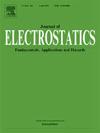电晕放电引起的离子风现象
IF 2.1
4区 工程技术
Q3 ENGINEERING, ELECTRICAL & ELECTRONIC
引用次数: 0
摘要
本文综述了大气中双电极体积电晕放电产生离子风的最新研究进展。我们的目的是准确地描述离子风的拓扑结构,并在实验测量和数值模拟的基础上解释其性质。本文中最常讨论的两种几何构型是点板和点环。在介绍和简要的物理现象的理论概述之后,我们描述了直流和交流电晕放电的不同制度,因为它们在诱导离子风的性质中起着关键作用。然后,在第三部分,我们讨论了离子风的时间平均特性。我们表明,正电晕放电产生一个尖锐、尖锐和快速的离子风射流,特别是当击穿飘带存在时。相反,负电晕放电通常产生更宽、更慢的气流。在第四部分中,我们描述了当高压接通时,空气从尖端运动。此外,我们强调了Trichel脉冲和击穿流在离子风动力学中起着重要的作用。最后,在本文的最后一部分,我们着重于离子风的数值模拟来解释前面提出的所有实验结果。事实上,离子风的起源是由放电产生的电流体动力。为了确定这种力,我们需要知道电场分布以及空间中任何时间任何地方的电子和离子的密度,这只能通过数值模拟来实现。总之,可以说,过去十年的研究已经使人们对离子风现象有了更好的理解,特别是关于非定常和非常快的现象,如Trichel脉冲和击穿流光的作用。但是,要根据目标应用对放电的所有输入参数进行优化,还需要做大量的实验和数值模拟工作。由于离子风的应用很可能是在小尺度上,小到亚毫米尺度,因此研究电晕放电的行为以及它们在这个尺度上产生的离子风也是必要的。本文章由计算机程序翻译,如有差异,请以英文原文为准。
On the phenomenon of ionic wind induced by corona discharges
This article reviews the latest knowledge on ionic wind generated by two-electrode volume corona discharges in atmospheric air. We aim to accurately describe the ionic wind topology and explain its properties based on experimental measurements and numerical simulations. The two geometric configurations most commonly discussed in this article are the point-plate and point-ring. After an introduction and brief theoretical overview of the physical phenomenon, we describe the different regimes of DC and AC corona discharges, as they play a key role in the properties of the induced ionic wind. Then, in the third part, we discuss the time-averaged characteristics of the ionic wind. We show that positive corona discharges produce a sharp, pointed, and fast ionic wind jet, especially when breakdown streamers are present. On the contrary, the negative corona discharges usually produce a wider and slower air jet. In the fourth part, we describe the air movement from the tip when the high voltage is switched on. Moreover, we highlight that the Trichel pulses and the breakdown streamers play a fundamental role in the ionic wind dynamics. Finally, in the last part of this article, we focus on numerical simulations of ionic wind to explain all the experimental results presented earlier. Indeed, the origin of the ionic wind is the electrohydrodynamic force produced by the discharge. To determine this force, we need to know the electric field distribution and the density of electrons and ions everywhere in space at all times, which is achievable only through numerical simulations. To conclude, it can be said that research over the past ten years has led to a much better understanding of the ionic wind phenomenon, particularly regarding the role of unsteady and very fast phenomena such as Trichel pulses and breakdown streamers. However, there is still a lot of experimental and numerical simulation work to be done to optimize all the input parameters of the discharge according to the targeted application. And since the applications of ionic wind will most likely be at small scales, down to the sub-millimeter scale, it will also be necessary to study the behavior of corona discharges and the ionic wind they can generate at this scale.
求助全文
通过发布文献求助,成功后即可免费获取论文全文。
去求助
来源期刊

Journal of Electrostatics
工程技术-工程:电子与电气
CiteScore
4.00
自引率
11.10%
发文量
81
审稿时长
49 days
期刊介绍:
The Journal of Electrostatics is the leading forum for publishing research findings that advance knowledge in the field of electrostatics. We invite submissions in the following areas:
Electrostatic charge separation processes.
Electrostatic manipulation of particles, droplets, and biological cells.
Electrostatically driven or controlled fluid flow.
Electrostatics in the gas phase.
 求助内容:
求助内容: 应助结果提醒方式:
应助结果提醒方式:


